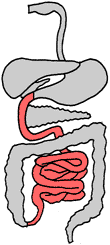 small intestine
small intestine
 C o o l ! S m a l l
C o o l ! S m a l l
i n t e s t i n e i n f o !
s m a l l i n t e s t i n e
![]() When the food leaves the stomach it goes into the small intestine, which
is the part of the digestive tract where most of digestion and absorption
takes place. The small intestine of an adult male averages about 7m in
length and 2-3cm in diameter. Structurally, it is a tubular organ, which
consists of a complex system of loops and coils, and fills a large part
of the abdominal cavity. The function of the small intestine is to receive
secretions from the liver and the pancreas, finalize the digestion of the
nutrients in chyme, absorb the different products of digestion, and move
the remaining residues to the large intestine.
When the food leaves the stomach it goes into the small intestine, which
is the part of the digestive tract where most of digestion and absorption
takes place. The small intestine of an adult male averages about 7m in
length and 2-3cm in diameter. Structurally, it is a tubular organ, which
consists of a complex system of loops and coils, and fills a large part
of the abdominal cavity. The function of the small intestine is to receive
secretions from the liver and the pancreas, finalize the digestion of the
nutrients in chyme, absorb the different products of digestion, and move
the remaining residues to the large intestine.
![]() It is made up of three major parts: duodenum, ileum, and jejunum. A
double-layered fold called mesentery connects all of the three.
It is made up of three major parts: duodenum, ileum, and jejunum. A
double-layered fold called mesentery connects all of the three.

![]() The small intestine has a very large surface area, because this is where
the products of digestion are absorbed. The inner lining of the small
intestine has a lot of folds and ridges, and small finger-like growths
called villi. The villi have cells that produce intestinal enzymes,
which complete the digestion. The base of the villi secretes large
amounts of a watery fluid. The fluid acts as a vehicle for moving the
digestive products into the villi. Once it is released it serves as a
medium in which the digestive products can move, and as soon as they
enter the fluid, it is being moved back into the villi.
The small intestine has a very large surface area, because this is where
the products of digestion are absorbed. The inner lining of the small
intestine has a lot of folds and ridges, and small finger-like growths
called villi. The villi have cells that produce intestinal enzymes,
which complete the digestion. The base of the villi secretes large
amounts of a watery fluid. The fluid acts as a vehicle for moving the
digestive products into the villi. Once it is released it serves as a
medium in which the digestive products can move, and as soon as they
enter the fluid, it is being moved back into the villi.
![]() The upper part of the small intestine, the duodenum, is the most active
during digestion. Secretions like bile from the liver, and digestive
enzymes and acid-neutralizing bicarbonate from the pancreas, are used
for digestion in the duodenum.
The upper part of the small intestine, the duodenum, is the most active
during digestion. Secretions like bile from the liver, and digestive
enzymes and acid-neutralizing bicarbonate from the pancreas, are used
for digestion in the duodenum.
![]() Carbohydrates, proteins, and fats are still digested in the small
intestine. The carbohydrates starch and glycogen are being broken down
into maltose. The proteins are being broken down into small peptide
fragments and some amino acids by proteases (enzymes secreted from the
pancreas). Bile liquidates fats, facilitating their breakdown until they
can be acted upon by lipases. Unlike carbohydrates and proteins, fats
are completely digested in the small intestine.
Carbohydrates, proteins, and fats are still digested in the small
intestine. The carbohydrates starch and glycogen are being broken down
into maltose. The proteins are being broken down into small peptide
fragments and some amino acids by proteases (enzymes secreted from the
pancreas). Bile liquidates fats, facilitating their breakdown until they
can be acted upon by lipases. Unlike carbohydrates and proteins, fats
are completely digested in the small intestine.
Diarrhea is a defense mechanism used by the body to remove diseases.
back to top